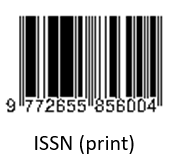Response Surface Modelling of the Mechanical Properties of Oil Palm Empty Fruit Bunch Fibre Reinforced Polyester Composites
(1) Middle East Technical University, Northern Cyprus Campus
(*) Corresponding Author
Abstract
This work presents a systematic approach to evaluate and study the effect of fibre aspect ratio and fibre volume fraction on the tensile strength, ultimate elongation, modulus of elasticity, strength and impact energy of oil palm empty fruit bunch fibre reinforced polyester composites. Hand-lay-up technique was used in the fabrication of the composite materials. Response surface methodology was used to study the effect of the selected factors on the mechanical properties of oil palm empty fruit bunch fibre reinforced polymer-based composite. The optimum fibre aspect ratio and fibre volume fraction for each mechanical property was determined. From the result of optimization, the maximum value for tensile strength obtained was 12.15MPa at a fibre aspect ratio of 64 and fibre volume fraction of 26%. The maximum value for ultimate elongation was obtained as 1.939% at a fibre aspect ratio of 124 and fibre volume fraction of 50%, the maximum value for modulus of elasticity was obtained as 1509 MPa at a fibre aspect ratio of 124 and 34% volume fraction. The maximum value for toughness was obtained as 0.1231MPa at a fibre aspect ratio of 89 and a volume fraction of 30%. The maximum value of impact energy was obtained as 5.765 ft/lbs at 28% fibre volume fraction and an aspect ratio of 69. The maximum value of impact strength was obtained as 4.574N/cm3 at a 36% volume fraction and an aspect ratio of 64.
Full Text:
PDFReferences
R. M. Guedes and J. Xavier “Understanding and Predicting Stiffness in Advanced Fibre-Reinforced Polymer (FRP) Composites for Structural Applications”, In Advanced Fibre-Reinforced Polymer (FRP) Composites for Structural Applications (pp. 298-360). Woodhead Publishing. 2013.
J. P. Jose, S. Thomas, J. Kuruvilla, S. K. Malhotra, K. Goda, M. S. Sreekala, “Advances in Polymer Composites: Macro-and Microcomposites—State of The Art, New Challenges, and Opportunities”, Polymer composites, 1, 3-16. 2012.
J. Kuruvilla, R. D. Toledo Filho, J. Beena, T. Sabu, and L. H. Carvalho, “A Review on Sisal Fiber Reinforced Polymer Composites”, Revista Brasileira de Engenharia Agrícola e Ambiental, 3(3), 367-379. 1999.
X. Li, , L. G. Tabiland, S. Panigrahi, “Chemical Treatments of Natural Fibre for Use in Natural Fibre-Reinforced Composites: A Review, Journal of Polymers and the Environment”, 15(1), 25-33. 2007.
S.M. Lee, D. Cho, W.H. Park, S.G. Lee, S.O. Han, and L.T. Drzal, “Novel Silk/Poly (Butylene Succinate) Biocomposites: The Effects of Short Fibre Content on their Mechanical and Thermal Properties”, Composites Science and Technology, 65, 647-657. 2005.
H. Y. Cheung, M. P. Ho, K. T. Lau, F. Cardona, and D. Hui, “Natural Fibre-Reinforced Composites for Bioengineering and Environmental Engineering Applications”, Composites Part B: Engineering, 40(7), 655-663. 2009.
E. C. Osoka and O. D. Onukwuli, The Optimum Condition for Mercerization of Oil Palm Empty Fruit Bunch Fibre, International Journal of Innovative Research in Computer Science and Technology, 3(4), 50-56. 2015.
D. Jones, G. O. Ormondroyd, S. F. Curling, C. M. Popescu, and M. C. Popescu, “Chemical Compositions of Natural Fibres. In Advanced High Strength Natural Fibre Composites in Construction”, (pp. 23-58), Woodhead Publishing, 2017. [9] M. Y. Hashim, A. M. Amin, O. M. F. Marwah, M. H. Othman, M. R. M. Yunus, and N. C. Huat, “The Effect of Alkali Treatment Under Various Conditions On Physical Properties of Kenaf Fibre”, In Journal of Physics: Conference Series 914(1), 012030. IOP Publishing, 2017.
A. K. Mohanty, M. Misra, and L. T. Drzal, “Surface Modifications of Natural Fibres and Performance Of The Resulting Biocomposites: An Overview”, Composite interfaces, 8(5), 313-343. 2001
A. Bismarck, A. K. Mohanty, I. Aranberri-Askargorta, S. Czapla, M. Misra, G. Hinrichsen and J. Springer. “Surface Characterization of Natural Fibres; Surface Properties and The Water Up-Take Behavior of Modified Sisal and Coir Fibres”, Green chemistry, 3(2), 100-107. 2001
L. A. Pothan, J. George, & S. Thomas, “Effect of Fibre Surface Treatments on the Fibre–Matrix Interaction in Banana Fibre Reinforced Polyester Composites”, Composite Interfaces, 9(4), 335-353. 2002.
N. T. Phuong, C. Sollogoub and A. Guinault, “Relationship Between Fibre Chemical Treatment and Properties of Recycled Pp/Bamboo Fibre Composites”, Journal of Reinforced Plastics and Composites, 29(21), 3244-3256. 2010
T., Padmavathi, S. V. Naidu & R. M. V. G. K. Rao. “Studies On Mechanical Behavior of Surface Modified Sisal Fibre–Epoxy Composites”, Journal of Reinforced Plastics and Composites, 31(8), 519-532. 2012.
Petinakis, E., Yu, L., Simon, G., & Dean, K. (2013). “Natural Fibre Bio-Composites Incorporating Poly (Lactic Acid)”, Fibre reinforced polymers-The technology applied for concrete repair, 41-59. 2013.
O. Faruk, A. K. Bledzki, H. P. Fink & M. Sain, “Biocomposites Reinforced with Natural Fibres: 2000–2010”, Progress in polymer science, 37(11), 1552-1596. 2012.
M. Y. Hashim, A. Zaidi, A. Mujahid, & S. Ariffin, “Plant Fiber Reinforced Polymer Matrix Composite: A Discussion On Composite Fabrication and Characterization Technique”. In Seminar to Faculty of Civil and Environmental Engineering (FKAAS), Universiti Tun Hussein Onn Malaysia (UTHM). 2012.
DOI: https://doi.org/10.24071/ijasst.v4i2.5129
Refbacks
- There are currently no refbacks.
Publisher : Faculty of Science and Technology
Society/Institution : Sanata Dharma University

This work is licensed under a Creative Commons Attribution 4.0 International License.











